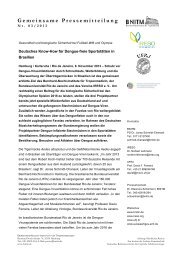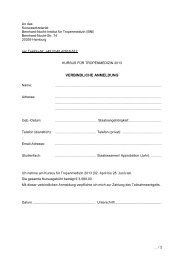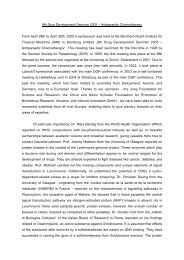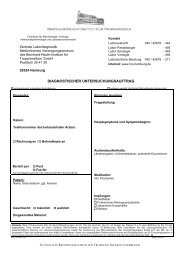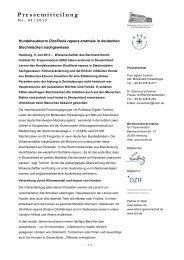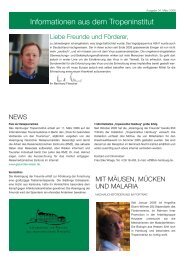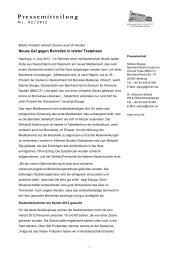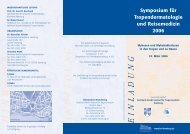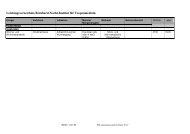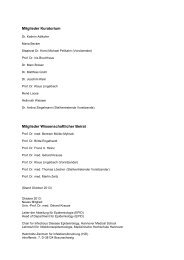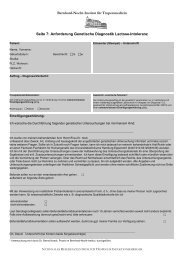Research Group Heussler (Malaria I) - Bernhard-Nocht-Institut für ...
Research Group Heussler (Malaria I) - Bernhard-Nocht-Institut für ...
Research Group Heussler (Malaria I) - Bernhard-Nocht-Institut für ...
You also want an ePaper? Increase the reach of your titles
YUMPU automatically turns print PDFs into web optimized ePapers that Google loves.
Parasitology Section<br />
Structural analysis of the glutathione S-transferase<br />
from Plasmodium falciparum<br />
Zusammenfassung<br />
Ein Hauptmechanismus xenobiotischer/antioxidativer<br />
Abwehrsysteme basiert auf der Glutathion-<br />
Konjugation, katalysiert durch die Glutathion S-Transferasen<br />
(GSTs). Plasmodium falciparum, der Erreger<br />
der <strong>Malaria</strong> tropica, besitzt eine einzige GST, der somit<br />
eine zentrale Rolle in der Detoxifikation zukommt.<br />
Ihre selektive und spezifische Inhibition stellt einen<br />
aussichtsreichen Ansatzpunkt <strong>für</strong> eine rationale<br />
Wirkstoffentwicklung dar. Durch die Klonierung und<br />
rekombinante Expression der GST von P. falciparum<br />
(Pf-GST) wurden Voraussetzungen zur Kristallisation<br />
und Röntgenstrukturanalyse des Proteins geschaffen.<br />
Die Pf-GST wurde sowohl mit als auch ohne den<br />
Inhibitor S-Hexylglutathion kristallisiert und ihre 3D-<br />
Struktur konnte mittels Röntgenbeugungsanalyse<br />
unter Anwendung von Synchrotronstrahlung aufgeklärt<br />
werden. Die erhaltenen Strukturdaten liefern<br />
eine wichtige Grundlage <strong>für</strong> die strukturbasierende<br />
Entwicklung neuer Antimalaria-Medikamente.<br />
Summary<br />
Glutathione S-transferases (GSTs) are involved in the<br />
detoxification of endogenous and xenobiotic compounds<br />
using either glutathione conjugation, glutathione<br />
peroxidase activity or passive/sacrificial binding.<br />
The critical role played by the sole GST of Plasmodium<br />
falciparum (Pf-GST) in detoxification makes it<br />
a viable drug target against malaria. For high-resolution<br />
crystallographic investigations, GST was overexpressed<br />
in bacterial cells and was crystallized in the native form<br />
and with the inhibitor S-hexylglutathione. By X-ray<br />
crystallography using synchrotron radiation, the threedimensional<br />
structure of the Pf-GST1 was determined.<br />
The obtained data forms the basis of structure-based<br />
design of selective inhibitors, which may serve as antimalarial<br />
drug leads.<br />
34<br />
Introduction<br />
Glutathione S-transferases (GSTs; EC 2.5.1.18) are a<br />
major family of detoxification enzymes that are found in<br />
organisms ranging from prokaryotes to mammals. They<br />
catalyse the nucleophilic addition of glutathione to a<br />
large variety of electrophilic substrates, thereby detoxifying<br />
both endobiotic and xenobiotic compounds. Besides<br />
catalyzing conjugation reactions, GSTs can also<br />
reduce organic hydroperoxides of phospholipids, fatty<br />
acids and DNA before they become engaged in freeradical<br />
propagation reactions, ultimately leading to the<br />
destruction of macromolecules during oxidative stress.<br />
In addition to their enzymatic functions, GSTs have<br />
been shown to serve in structural roles (S-crystallins) or<br />
act as regulatory proteins. For example, GSTs are involved<br />
in the sequestering and transport of exogenous<br />
potentially toxic compounds such as pesticides, herbicides<br />
and antibiotics and have been shown to bind a<br />
large variety of endogenous compounds such as<br />
steroids, bilirubin, bile acids and ferriprotoporphyrin IX<br />
with high to moderate affinities. Within a parasitic context,<br />
it is especially important to consider their function<br />
in the regulation of oxidative stress response, in drug<br />
resistance and possibly in the modulation of host<br />
immune defense mechanisms.<br />
Figure 1: Initial small crystals of Pf-GST. (b) Crystals after optimization<br />
with dimensions of up to 0.4 x 0.4 x 0.3 mm.



